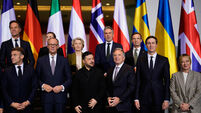Red Cross moves to accept new emblem
Years of campaigning is on the verge of bringing the Israelis and Palestinians into the Red Cross humanitarian movement, thanks to a pending solution in Switzerland to bridge long-standing sensitivities over Crusaders, crosses and crescents.
The two-day International Conference of the Red Cross and Red Crescent, which opened today in Geneva, is being asked to approve changes to meet Israeli demands of almost six decades that it be granted full membership without using the cross or crescent to identify itself.














